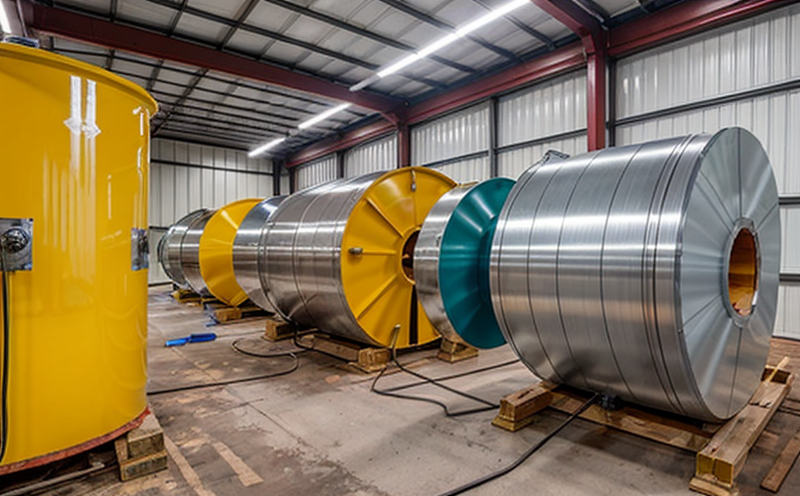Humidity Cabinet Resistance Test
The Humidity Cabinet Resistance Test is a critical procedure used to evaluate the performance of coatings, paints, and anti-corrosion protection materials in marine environments. This test simulates the harsh conditions found on ships and offshore structures where prolonged exposure to high humidity levels can lead to accelerated corrosion and degradation.
Marine equipment often operates under extreme environmental pressures, including salt spray, humidity, and temperature fluctuations. Ensuring that coatings and paints provide effective protection against these elements is essential for the longevity and safety of marine assets. The Humidity Cabinet Resistance Test provides a controlled environment to assess how well the coating resists moisture ingress and degradation over time.
In this test, specimens are subjected to elevated humidity levels within a cabinet that mimics real-world conditions. The goal is to observe any changes in the integrity of the coating or paint film after exposure. This includes checking for blistering, peeling, cracking, or loss of adhesion. By conducting these tests, manufacturers and end-users can ensure their products meet regulatory standards and perform reliably under expected marine conditions.
The test is conducted according to several international standards, including ISO 12944-3:2017, which provides guidelines for the application of coatings in maritime environments. The standard specifies that specimens should be exposed to a minimum humidity level of 95% RH (relative humidity) and maintained at this level for a specified duration. This ensures that any moisture-related degradation is accurately measured.
During the test, it's crucial to follow precise procedures to ensure accurate results. Specimens are typically prepared by applying the coating or paint according to manufacturer specifications. The coated specimens are then placed in a humidity cabinet where they remain for a set period, usually ranging from 72 hours to several weeks depending on the desired exposure level and expected service life of the product.
Upon completion of the test, inspectors carefully examine the specimens for any signs of degradation. The results are documented using detailed reports that include observations such as color changes, loss of gloss, or the presence of any visible defects. These reports serve as critical evidence for compliance with regulatory requirements and provide valuable data for product development and improvement.
The Humidity Cabinet Resistance Test is particularly important in sectors where marine equipment plays a key role, such as shipbuilding, offshore oil rigs, and coastal infrastructure. By leveraging this testing method, stakeholders can make informed decisions about the suitability of their coatings and paints for specific applications. This not only enhances product performance but also contributes to cost savings by preventing premature failures and reducing maintenance costs.
Understanding the importance of this test is crucial for quality managers, compliance officers, R&D engineers, and procurement personnel involved in marine equipment design and manufacturing processes. By integrating such tests into their quality assurance protocols, organizations can ensure that they are delivering reliable products that meet both industry standards and customer expectations.
Why It Matters
The Humidity Cabinet Resistance Test is vital for ensuring the durability and effectiveness of coatings, paints, and anti-corrosion protection materials used in marine environments. In sectors like shipbuilding and offshore oil rigs, equipment must withstand harsh environmental conditions that can lead to accelerated corrosion if not properly protected.
- Simulates real-world humidity levels found in maritime environments
- Evaluates the resistance of coatings to moisture ingress
- Assesses the integrity and adhesion of paint films over time
- Mitigates risks associated with premature degradation and failure
- Ensures compliance with international standards for maritime applications
The results of this test provide critical insights into how well coatings and paints perform under expected operational conditions. This information is essential for manufacturers to improve product quality, extend service life, and meet regulatory requirements. For end-users, the test helps in selecting reliable products that can withstand the challenging marine environment without compromising safety or performance.
Applied Standards
The Humidity Cabinet Resistance Test is governed by several international standards designed to ensure consistent and accurate testing methods. The primary standard used in this context is ISO 12944-3:2017, which specifies the application of coatings for corrosion protection in marine environments.
According to ISO 12944-3, specimens are exposed to a high humidity environment (typically 95% RH) for extended periods. The duration of exposure can vary based on the specific requirements and expected service life of the coating or paint being tested. This standard provides detailed guidelines on specimen preparation, test conditions, and evaluation criteria.
Other relevant standards include ASTM D1658-14, which offers additional methods for evaluating the resistance of coatings to moisture penetration, and EN 12944, which covers the application of protective coating systems for structures exposed to salt spray. By adhering to these standards, laboratories can ensure that their test procedures are consistent with internationally recognized best practices.
The use of these standards not only enhances the reliability of test results but also facilitates global trade by ensuring compatibility across different regions and jurisdictions. Compliance with international standards is crucial for manufacturers seeking to export their products or comply with regulatory requirements in various countries around the world.
Quality and Reliability Assurance
- Consistency of Results: By following standardized procedures, laboratories can ensure that test results are consistent and reproducible. This is particularly important in quality assurance programs where uniformity across different batches or lots is critical.
- Adherence to Specifications: The Humidity Cabinet Resistance Test helps manufacturers verify that their products meet the specified performance criteria outlined in relevant standards. This ensures that coatings and paints are reliable and effective in real-world applications.
- Identification of Defects: Through careful observation during and after the test, inspectors can identify any defects or issues with the coating that could lead to premature failure. Early detection allows for corrective actions to be taken before products reach end-users.
- Enhanced Customer Satisfaction: By providing reliable coatings and paints that pass stringent testing protocols, manufacturers enhance customer trust and satisfaction. This leads to increased market share and repeat business.





